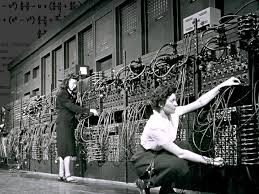
August 30 marks the 127th anniversary of the birth of John William Mauchly who along with J. Presper Eckert invented the first electronic digital computer. Born in Cincinnati, Mauchly earned a PHD in physics from Johns Hopkins University in 1932.
Mauchly became chairman of the physics department at Ursinus College where he also pursued his lifelong interests in meteorology and electrical engineering. At the time, the analysis of weather patterns was a laborious process even with mechanical calculators. Mauchly was working on ground-breaking ways to automate these calculations when he answered the call to help the U.S. Army’s Ballistic Research Laboratory during WWII. His first project was the calculation of artillery firing tables and he then became involved in feasibility studies for the hydrogen bomb.
In 1945, Mauchley and Eckert introduced their Electrical Numerical Integrator And Calculator (ENIAC). The ENIAC was approximately 1,800 square feet in size and weighed 30 tons. Other mainframe computers that soon followed were so large that they filled entire floors of buildings. The computers were typically owned by large corporations or government agencies to perform complex calculations and scientific research.
How does the ENIAC compare to your laptop aside from the fact you don’t need a second house to hold your PC? The ENIAC had a processing speed of about 5,000 instructions per second. Your laptop is 30,000 times faster than the ENIAC, executing billions of instructions per second. Your iPhone crushes the ENIACs processing power with the iPhone 14 being capable of performing 17 trillion operations per second. And, an iPhone has tens of thousands of times more memory than the 30 ton ENIAC.
BITS and BYTES
John Mauchly received a doctorate from Johns Hopkins even though he never completed requirements for his bachelor’s degree. The list of college dropouts who became tech icons include Bill Gates, Mark Zuckerberg, Jack Dorsey (Twitter) and Larry Ellison (Oracle).
Despite the wonderous technology that we can now hold in our hand, today’s most advanced devices are no match for the power of the human brain. The typical brain can process 38 thousand trillion operations per second and store more than 3580 terabytes of memories.
The first webcam was utilized by Cambridge University researchers so they could monitor their coffee maker.
The longest word that you can type using the letters on only one row of your keyboard is “typewriter”.
The first person to earn a Ph.D. in Computer Science in the United States was Mary Kenneth Keller, a Catholic nun.
In 1999, the world’s top two search engines were Yahoo and Excite. Google co-founder Larry Page offered his technology to Excite for $750,000 and 1% of Excite stock. The deal fell through because the established company’s executives did not like Page’s insistence that Google would be Excite’s new search engine. Today, Google’s market cap is over $2 Trillion and most people don’t remember Excite.
Americans throw away 14 million mobile devices each year despite these devices containing precious metals like gold and silver. On an annual basis, Americans toss $60 million in gold and silver straight into the trash.
The decentralized digital currency Bitcoin launched in early 2009. The following year, the first Bitcoin transaction occurred when Laszlo Hanyecz bought two pizzas from 19 year old student Jeremy Sturdivan for 10,000 bitcoins. The value of the coins was $41.00 and Sturdivan quickly spent his take. The current value of a Bitcoin is 64,000 and Sturdivan’s mislaid coins would be worth $365M.
Satoshi Nakamoto is the pseudonym used by the person or persons that created Bitcoin and researchers still don’t know the actual identity (ies) of the people behind the curtain. So if you feel badly that you don’t understand Bitcoin – Don’t. And, as somebody who spent years in cyber security my advice is “Runaway”.
Have a great weekend. I won’t be blogging in September. Enjoy the rest of the summer.
Thanks to all of you who have purchased my book and thanks for all of the rave reviews. If you haven’t bought your copy please visit www.tedcurtinstories.com for direct links to Amazon and Barnes and Noble.
H
a